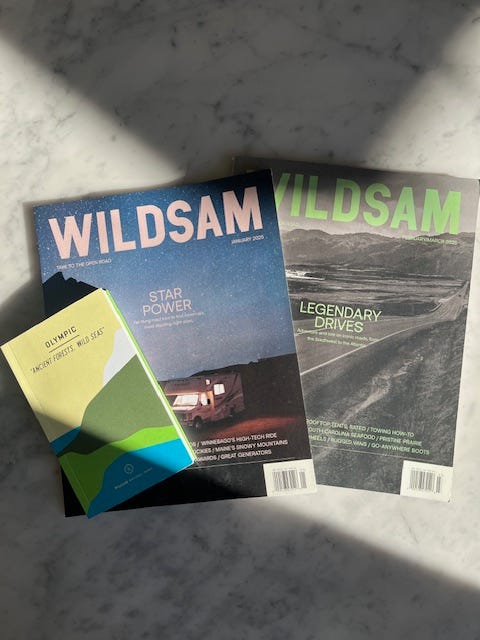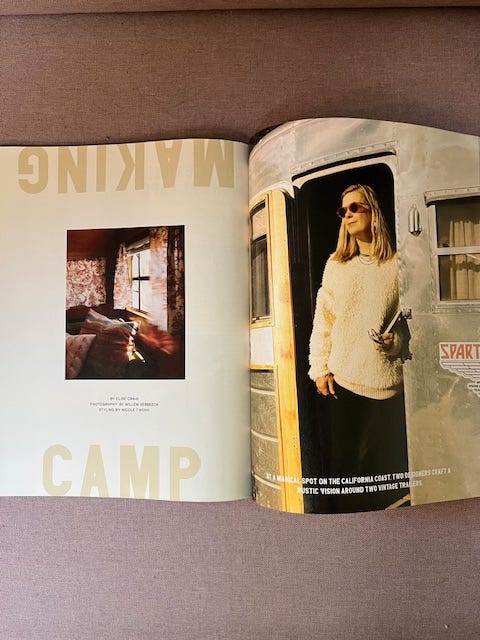David Lynch, Twin Peaks, Montana and the “Northwest Moment”
Plus: Olympia, Edith Heath and five fresh albums out of the West
The death of filmmaker David Lynch took over my various media streams last week. Probably yours, too. The creative universe diverted en masse from the dismal daily to mourn a singular maker of alternative worlds. And like so many, I felt moved to write about the man—to remember his foghorn voice, gorgeous hair, wild and beautiful films and, especially, what he meant in my corner of the continent.
I was lucky to do just that for The Pulp1, the nonprofit, independent news organization in my hometown of Missoula. (Missoula was also David Lynch’s birthplace; it’s his birthday-week right now, cosmically enough.) My piece on Lynch hit the site this week: a meditation on the very first episode of Twin Peaks, transformative commercial television that defined Lynch’s vision of his birth-region, the Inland Northwest.
I said most of what I have to say in the Pulp story, but a couple stray threads continue to ricochet.
First, I didn’t write directly about how much my sect of Missoula art-nerd kids loved Twin Peaks. For a year, Twin Peaks was basically the organizing principle of my social life. A big troupe of us would gather every week for new episodes, with a cultic fervor that transformed a project that was, for a hot second, the buzziest show on network TV into a private, secret-society fixation.
In retrospect, I think we loved it so much in part because we saw ourselves—our best-looking, most mysterious selves—in Twin Peaks’ forest-dwelling weirdniks and misty landscapes. My Pulp piece is all about this. It’s not that the Inland Northwest—Western Montana, Northern Idaho, Eastern Washington: all places Lynch lived as a kid—hadn’t been documented. But no popular art had elevated us—reimagined and enchanted our realm with Twin Peaks’ intensity.
And as I wandered into this very specific territory, the degree to which Twin Peaks’ debut and big cultural splash in 1990 fit a larger “Northwest moment” struck me. I cued up Gus Van Sant’s Drugstore Cowboy, released just the year before. Watched back-to-back, the Twin Peaks’ pilot episode and Drugstore Cowboy articulate notably similar aesthetics. They both turn a retro-inflected Northwest into a world of noir style and surreal vibration. (Van Sant’s movie is obviously more literal, based on real-deal criminal James Fogle’s novel and filmed in a scraggly Portland that can still be found, here and there.)
Between them, these two works on film helped lend the Northwest an edgy, sexy cool we’d never had before. They arrived in a rough choreography with music boiling out of Seattle, Olympia and Portland in that late ‘80s / early ‘90s era, plus other literature and cinema that gave the Far Corner cultural brio, maybe for the first time.
Whether we’ve still got it—that’s a question for another day.
*
In other home front news, mystically related: In my working life for Wildsam, we recently released a book about Olympic National Park and its surrounds. Gentle reader, if you don’t know Wildsam’s “field guide” series, the books cross-pollinate travel intel and cultural perspective. As lead editor on the Olympic project, I took full journalistic license with the latter half of that, weaving in as much off-center Pacific Northwestiana as I could justify.
Notably, the book’s pocket-sized pages include plenty of Olympia-adjacent underground and bohemian heritage. The great cut-paper artist Nikki McClure generously gave an interview; a select roster of International Pop Underground Convention artists slides in near a timeline of Nirvana’s earliest days. We give quick nods to Quilcene’s Gray Coast Guildhall, the inspiring cidery/live venue Finn River in Chimacum and, of course, Olympia’s Le Voyeur, K Records and Killrockstars.
What’s the relationship between the Olympic Peninsula’s landscape of wild coastline and dense rainforest and the rogue creativity that thrives there? A question too deep for Wildsam’s cheerful ramble, and for this ‘zine, too. Find your way to the field guide’s story about bygone boho hang Olympus Manor for some shaggy thoughts.
*
At Wildsam, we also create a magazine that takes our focus on American place and culture out on a perpetual roadtrip. I could talk all day about this magazine, its many ins and outs. For the moment, from a RED HORIZON perspective, one piece of note in our February/March issue touches on the legacy of Edith Heath.
Edith Heath is a person I need to learn more about. Founder of Heath Ceramics, she was a philosopher of craft and aesthetics, working from a distinctively Western/Californian point of view. Our magazine’s story focuses Heath’s current proprietors, Catherine Bailey and Robin Petravic, and a killer place they’ve created on the California coast. But hints of Edith’s life’s work peek in here and there, and in working with writer Elise Craig and glowy photos by Willem Verbeeck, I felt like I was standing in the antechamber of a much bigger story. Which, honestly, is the best feeling for a magazine editor.
*
I got into this Substack hustle too late to drop a “here’s all the things from 2024” list, so let’s close with some musical recs from this side of the continent and relatively adjacent nodes of spacetime:
Haley Heynderickx, Seed of a Seed
Portland’s hardest-to-spell songwriter resonates on formidable post-Joni frequencies.
Terror/Cactus, Forastero
Psychedelic electro-cumbia, from Seattle but with Buenos Aires and Miami connections? Let’s do it. Let a thousand flowers bloom, a thousand schools of thought contend.
Reyna Tropical, Malegría
This one is worth a mixed-up micro-essay of its own, but suffice to say, Fabi Reyna is a star and this record brings uplift and heartbreak in equal measure.
Bella White, “Five For Silver” EP
Ripping and wrenching honky-tonk covers by this sweet-voiced child of Calgary.
Charley Crockett, $10 Cowboy
You can go ahead and find this one. Our thick-twanged antihero here seemed to be in an unofficial competition with Fucked Up for “most productive” honors in 2024, knocking out two LPs and at least one single. Do your reading mind a favor and track down John Spong’s Texas Monthly profile, too.







Finally the internet redeems itself! I really enjoyed both of your posts, but David Lynch was a formative influence for me as well, so this one hit hard. In fact, when Brian and I met each other at a party in New York in 1995, we spent most of the time talking about Twin Peaks and My Own Private Idaho, which both remain my favorite TV show and movie.
The West is a state of mind; I look forward to reading more of your take on it.
*nods and offers a meaningful glance with an inscrutable hand gesture*